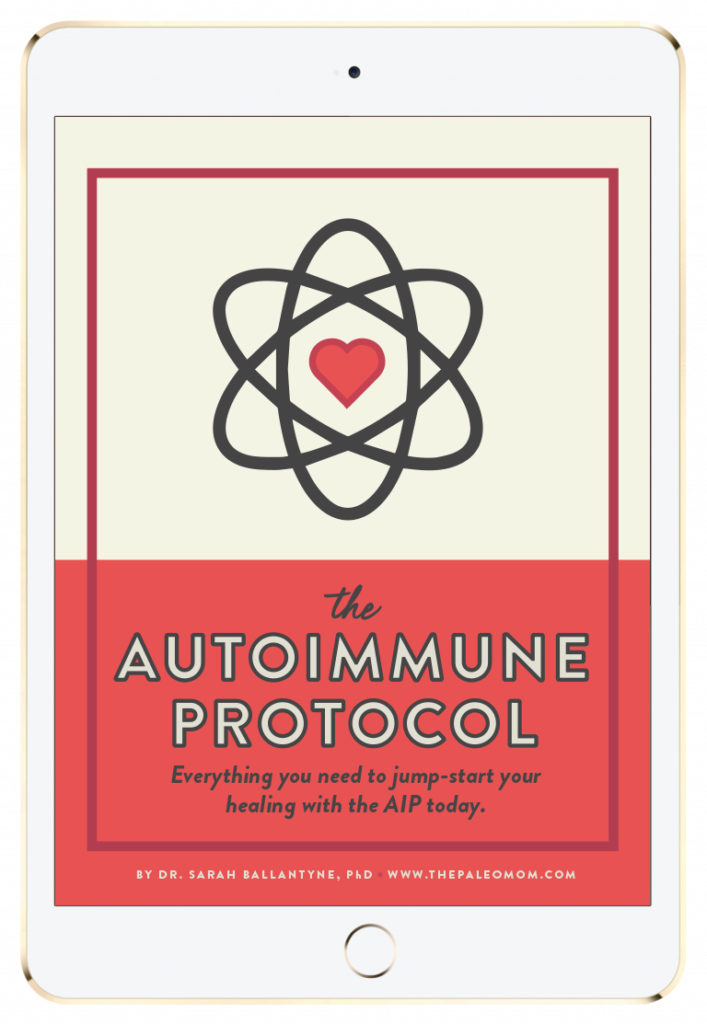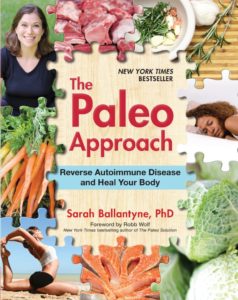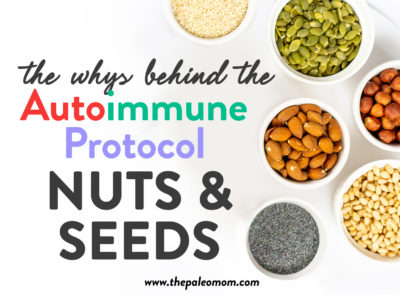 The autoimmune protocol is, by default, a fairly low-carbohydrate diet. This is especially true for those with gastrointestinal symptoms, suspected or confirmed Small Intestinal Bacterial Overgrowth, and/or FODMAP sensitivity because these conditions warrant the elimination of starchy vegetables. Sugar (even from fruits and starchy vegetables) can be a strong trigger for many with autoimmune disease, so many people find that even fruit can aggravate their symptoms. This is because sugar itself is inflammatory but also because the insulin secreted to help our bodies use and store that sugar is inflammatory. The most effective version of the autoimmune protocol for most people is a fairly low carbohydrate implementation (although typically not so low that you are going into ketosis). This is a fabulous way to lose weight and many overweight people with autoimmune disease see the weight loss that goes with this diet as an added bonus to managing their disease (or maybe a silver lining to living with such a restricted diet).
The autoimmune protocol is, by default, a fairly low-carbohydrate diet. This is especially true for those with gastrointestinal symptoms, suspected or confirmed Small Intestinal Bacterial Overgrowth, and/or FODMAP sensitivity because these conditions warrant the elimination of starchy vegetables. Sugar (even from fruits and starchy vegetables) can be a strong trigger for many with autoimmune disease, so many people find that even fruit can aggravate their symptoms. This is because sugar itself is inflammatory but also because the insulin secreted to help our bodies use and store that sugar is inflammatory. The most effective version of the autoimmune protocol for most people is a fairly low carbohydrate implementation (although typically not so low that you are going into ketosis). This is a fabulous way to lose weight and many overweight people with autoimmune disease see the weight loss that goes with this diet as an added bonus to managing their disease (or maybe a silver lining to living with such a restricted diet).
But what if you don’t have weight to lose?!
An often glossed-over fact is that a large percentage of autoimmune disease patients are underweight (or at least not overweight). The last thing these people need is to follow a diet conducive to weight loss! And if you suffer from a disease in which flares mean dramatic weight loss (as is the case with inflammatory bowel diseases but also many other severe autoimmune diseases), then you probably prefer walking around with a little extra weight to help protect yourself from getting too ill should you experience another flare–and the sad truth about autoimmune disease is that even following the AIP is not a guarantee that you will never flare again. This diet is a management strategy and not a cure.
So, how do you gain weight while following the autoimmune protocol? The most important thing is to increase overall caloric intake. So, first and foremost, eat more fat–especially healthy, easy to digest, healing fats.
The best fat sources are:
- Coconut Oil (my preference is Gold Label from Tropical Traditions)
- Palm Oil (Red Palm Oil from Tropical Traditions is ethical and sustainable) – NOT Palm Kernel Oil
- Palm Shortening
- Avocado Oil (not for cooking)
- Olive Oil (not for cooking)
- Avocadoes—this is a FODMAP so be cautious
- Olives
- Tallow from grass-fed beef or lamb
- Lard from pastured pigs
- Fatty cuts of meat and organ meat from grass-fed and pastured animals
- Fermented Cod Liver Oil
- Fatty wild-caught cold-water fish (salmon, sardines, mackerel…)
- Full-fat coconut milk
- Coconut Butter (aka coconut cream concentrate or creamed coconut)—this is a FODMAP, so be cautious
The fats in coconut and palm are especially easy to digest. These medium chain triglycerides (MCTs) can be passively absorbed (no digestive enzymes necessary) and used as fuel by your cells without modification. These MCTs are also antimicrobial, so they are very useful for those with overgrowth of bacteria or yeast in their digestive tracts, and they promote healing. Saturated fats are not easily oxidized so they supply the body with essential fatty acids without causing inflammation. The conjugated linoleic acid (CLA) in the fat from grass-fed animals has potent anti-inflammatory properties and can help promote healing. The omega-3 fats in fish and the fat from grass-fed animals is also critical for reducing inflammation.
Saturated fats are the best for cooking. This means that good cooking fats are coconut oil, palm oil, palm shortening, tallow, and lard. Monounsaturated fats are better used raw such as in dressings for salads and steamed vegetables. Olive or avocado oil makes a great dressing with lemon juice, lime juice, or balsamic vinegar (you can throw some herbs in too if you like). When mono- and polyunsaturated fats are part of a whole food (as in grass-fed meat, fish, olives and avocado), they are less likely to oxidize with cooking.
In conjunction with eating more fat, it’s important to have enough carbohydrates in your diet for your body to store the fat. You need some insulin to store fat. I recommend getting these carbohydrates from higher glucose fruits and from glucose-based starches for those without Small Intestinal Bacterial Overgrowth.
Higher glucose fruits include:
- Bananas (the best choice)
- Pineapple
- Apricots (FODMAP, so use with caution)
- Plums/prunes (also FODMAP)
- Grapes
- Raisins
- Figs
- Dates
Because you don’t want to overdo the sugar, dose is important here. Whether your carbs come from fruit or starchy vegetables (see below), aim to consume between 15g and 30g of carbohydrates with each meal (perhaps as much as 45g with a large meal). This will ensure your blood glucose doesn’t get high enough to cause problems, but that there’s enough insulin to help store fat. Other lower sugar fruits are just fine too, such as berries, citrus and some melons. Look for any fruit that is at least half glucose compared to fructose. If the sugars are more than half fructose, then avoid those fruits (there’s a great table here; look for the fructose number being smaller than or the same as the glucose number).
Save 70% Off the AIP Lecture Series!
Learn everything you need to know about the Autoimmune Protocol to regain your health!
I am loving this AIP course and all the information I am receiving. The amount of work you have put into this is amazing and greatly, GREATLY, appreciated. Thank you so much. Taking this course gives me the knowledge I need to understand why my body is doing what it is doing and reinforces my determination to continue along this dietary path to heal it. Invaluable!
Carmen Maier

Lower starch starchy vegetables are often well tolerated. These include:
- Winter squash (e.g. butternut, acorn, spaghetti)
- Onion
- Beet
- Carrots
- Rutabaga
- Jicama
- Kohlrabi
- Turnips
- Pumpkin
If you know from experience that you can handle denser starch starchy vegetables, then by all means go for it.
Don’t forget the protein. Protein from quality meats and fish is still essential. You should be aiming to consume anywhere between ½ and 1 gram of protein per pound of your bodyweight per day. For me, this amounts to at least 6oz of meat or fish with each meal.
For those with difficulty digesting food (basically, if you have any digestive symptoms), cooked vegetables (and even stewed fruits) will be the easiest to digest. Some people report diarrhea from coconut and palm oils, which may be due to die-off (the excess bacteria in your gut dying). If you do experience diarrhea from too much fat with each meal, pull back on the dose. You can add a teaspoon of coconut oil between meals several times a day, which is typically a small enough dose to be well tolerated. If you digest animals fats better, then it’s perfectly fine to just stick with that.
Other factors that will help with normalizing weight are getting enough rest, managing stress, and making sure you have enough Vitamin D. Anything you can do to help reduce inflammation and heal the gut will help you absorb more nutrition from your food, regulate hormones, and regulate your weight (basically following the autoimmune protocol is designed to do this). L-glutamine and zinc can be very useful supplements for those with autoimmune disease to help restore gut barrier function. Probiotics, either as a supplement or from live fermented foods, can also be beneficial since our gut microflora have an important role to play in our digestion.
I don’t advocate eating more frequently to try to gain weight since there is pretty good evidence that spacing out meals (4-5 hours between them) is better for regulating some hormones that are key in reducing inflammation. However, a mid-day snack would be appropriate (try to get at least 3 hours between your meal and snack) for those with schedules that would mean that more than 5-6 hours would pass between meals. Also, while eating shortly before bed can completely undermine one person’s attempt to lose weight, it might be a good tool for those trying to gain weight. This is because eating carbohydrates (whether on their own or with a meal) can suppress the release of human growth hormone, which is required for the body to convert stored fat into glucose. If there is less human growth hormone in your system, your body cannot as easily burn fat while you sleep. There is a balance here because this can also affect sleep quality, which is why people who have difficulty sleeping are advised to not eat for at least 2-3 hours before bed. If sleep is an issue for you, try to eat around 2 hours before bed, otherwise, you can try as close to bedtime as 1 hour, but watch for signs that your sleep is not as restorative as usual (getting up to pee in the night, remembering many dreams when you wake up, having a harder time getting out of bed in the morning, a crash of energy in the afternoon, feeling moody or feeling like you’re not thinking clearly).
It might take a little self-experimentation to figure out how to eat to achieve a healthy weight while following the autoimmune protocol, but gaining weight is completely achievable. Remember that slow and steady wins the race and don’t get too frustrated if it takes a few weeks to figure out exactly what is going to work for you.










